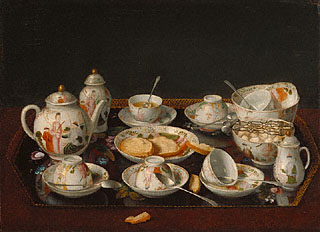• Identify the subject of this painting. What designs do you see on the surfaces of the objects? What designs do you see on the surface of the tray? (It is a still life of a Chinese porcelain tea set on a tray decorated with floral imagery.)
• Why do artists choose to paint still-life paintings? (Still-life subjects let artists show their skill in painting different surface textures, in this case the reflective and translucent porcelain tea set on an imitation lacquer tray. Still life is often used to show the theme of the passage of time.)
• What do you think the message of this particular still life might be?
• Why do you think the artist chose to present the objects after their use? (Liotard is being inventive and playful with this still life by showing us expensive import items in a state of disarray.)
• If you were going to paint a still life of a porcelain tea set, how would you choose to present your subject?
• This painting presents two export items from the Far East: porcelain and tea. Besides the drinking of tea, what other customs or inventions did the western world receive in trade with China? (Fireworks, the compass, astronomical observatories, decimal mathematics, paper money, umbrellas, wheelbarrows, printing press, the game of chess, etc.) |
Chinese porcelain and tea drinking were the rage of fashionable Europe when Jean-Étienne Liotard was born. He began painting tea and coffee sets in the last two decades of his life when age, changes in taste, and his political beliefs caused a decline in requests for the
pastel portraits that were his specialty. He had, however, been including fruit and porcelain still-lifes in some of his portraits since about 1740. Only five of his paintings of tea and coffee sets are known today.
In this painting of tea-time disarray, a tray is set with six cups and saucers, a teapot, sugar bowl, milk jug, and a lidded vase, perhaps containing an extra supply of tea leaves. A large bowl holding a teacup and saucer could also be used for dumping the slops of cold tea and used tea leaves. By the time Liotard painted this work in the late 1700s, tea drinking had become fashionable among the middle class, as well as the upper class. Liotard contrasted the luxurious materials of Chinese porcelain and silver with a cheaper tray of painted tin, known as tôle, that imitated Asian lacquer. Combining the transparent, reflective, and brightly patterned objects allowed the artist to portray strong visual contrasts.
About the Artist
Jean-Étienne Liotard first trained as a miniature painter in Geneva, where he mastered the extraordinary fineness of application that was to be the hallmark of his pastel style. While in his 20s he sought his fortune in Paris, where he studied in a prominent painter's studio. After rejection by the Académie Royale, he traveled to Italy, where he obtained numerous portrait commissions. Liotard next embarked on a journey throughout the Mediterranean region and finally settled in Constantinople for four years. Intrigued by the native dress, he grew a long beard and acquired the habit of dressing as a Turk, earning himself the nickname of "the Turkish painter." While in Constantinople, he painted portraits of members of the British colony.
For the remainder of his life, Liotard traveled throughout Europe painting portraits in pastels. He gained an international reputation in this medium for his care and skill in achieving an accurate likeness of his sitters. At the age of 79, he published a treatise on the principles of painting, in which he explained his belief that painting is and should be a mirror of nature.
|
